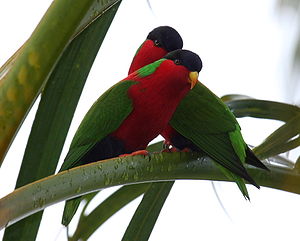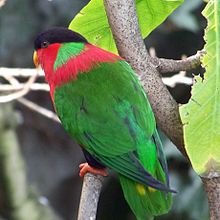- Collared Lory
-
Collared Lory At Matei, Taveuni, Fiji Isles Conservation status Scientific classification Kingdom: Animalia Phylum: Chordata Class: Aves Order: Psittaciformes Family: Psittacidae Tribe: Lorini Genus: Phigys
G R Gray 1870Species: P. solitarius Binomial name Phigys solitarius
(Suckow, 1800)The Collared Lory (Phigys solitarius) is a monotypic species of parrot in the Psittacidae family, and it is the only species in the genus Phigys. It is endemic to the islands of Fiji. It is the only Fijian rainforest bird to adapt to urban landscapes and can be found in urban Suva. Measuring 20 cm (8 in), it has bright red underparts and face with a purple crown and greenish upperparts. Males and females are similar in plumage, although the latter have a paler crown.
Contents
Description
Adult birds are around 20 cm (8 in) long and exhibit slight sexual dimorphism. The male has bright scarlet cheeks, throat, breast, and upper abdomen. The crown is dark purple. The nape is lime green and red and some of the feathers on the nape are elongated. The wings, back, and tail are greenish. The lower abdomen is purple. The bill is yellow-orange, the feet pink-orange, and the irises are orange-red. The female is similar but with a paler crown that has a greenish hue posteriorly. Juveniles are duller with vague purple transverse striations on the upper abdomen and breast, and they have a brown beak and pale brown irises.[1][2]
Taxonomy
The Collared Lory was first described by German naturalist Georg Adolf Suckow in 1800, and placed in the genus Phigys by English naturalist George Robert Gray in 1870. It is a monotypic species of the genus Phigys.[3] The species is sometimes considered to be in the genus Vini.[4]
The Fijian name is Kula.[5] The bird was prized throughout western Polynesia for its vibrant plumage and the maritime trading networks based on "kula" feathers existed between Fiji, Samoa, and Tonga up until colonial times. Both the bird and its plumage are called "ula" in Samoan and "kula" in Tongan. Alternate common names include Fiji-Lory, Ruffled-Lory, and Solitary Lory. The last is a misnomer as the species isn't solitary.[6]
Distribution and habitat
Its natural habitat is subtropical or tropical moist lowland forests. It has adapted to human habitation and can be found in Suva. It occurs on Fiji's larger islands, and on the Lau Islands outwards to Lakeba and Oneata.[1] While the species is today restricted to Fiji, fossil evidence shows that it once occurred in Tonga as well, and was extirpated by early human settlers.[4]
Matei, Taveuni, Fiji Isles
Behaviour
The Collared Lory is a fast and straight flyer with quick shallow wingbeats, and can be found in pairs or small groups.[1] The call is a high pitched single or double shriek.[7]
Feeding
The diet of the Collared Lory consists fruit, seeds, nectar and blossoms. Trees favoured include the Drala (Erythrina variegata), the Coconut Palm (Cocos nucifera) and the introduced and invasive African Tulip tree (Spathodea campanulata).[8]
Breeding
The nest is a hollow in a tree, or sometimes in a hole in a rotting coconut still attached to the tree. The clutch size is two eggs in ccaptivity, the size in the wild is unknown but presumed to be the same. Incubation is around 30 days,[7] and the nestling stage lasts about 9 weeks.
Aviculture
The Collared Lory was bred and exhibited in London and Taronga Zoos in the early 1940s. The species became tame readily in captivity but early attempts to keep birds alive proved difficult.[9]
Photographs
References
- ^ a b c Forshaw, p. 80
- ^ Forshaw (2006). plate 15.
- ^ "Zoological Nomenclature Resource: Psittaciformes (Version 9.022)". www.zoonomen.net. 2009-03-28. http://www.zoonomen.net/avtax/psit.html.
- ^ a b Steadman D, (2006). Extinction and Biogeography in Tropical Pacific Birds, University of Chicago Press. ISBN 978-0-226-77142-7
- ^ Mercer, Robin (1967). A Field Guide to Fiji Birds. Suva: Government Press. pp. 9.
- ^ Low, p. 137
- ^ a b Forshaw, p. 81
- ^ Mercer, p. 10
- ^ Low, p. 139-42
- BirdLife International 2008. Phigys solitarius. 2008 IUCN Red List of Threatened Species. Downloaded on 5 May 2009.
Cited texts
- Forshaw, Joseph M. (2006). Parrots of the World; an Identification Guide. Illustrated by Frank Knight. Princeton University Press. ISBN 0691092516.
- Forshaw, Joseph M. and Cooper, William T. (1978). Parrots of the World (2nd ed.). Melbourne: Landsdowne Editions. ISBN 0-7018-0690-7.
- Low, Rosemary (1978). Lories and Lorikeets. Melbourne: Inkata Press. ISBN 0-909605-08-4.
External links
Lories and lorikeets (Tribe: Lorini) Genus Species (taxonomy note: * indicates taxa that may classified as a subspecies of the Rainbow Lorikeet or a separate species)
(extinctions: † indicates a species confirmed to be extinct, ₴ indicates evidence only from sub-fossils)Chalcopsitta Eos Pseudeos Trichoglossus Ornate Lorikeet • Pohnpei Lorikeet • Mindanao Lorikeet (or Johnstone's Lorikeet) • Citrine Lorikeet (or Yellow-and-green Lorikeet) • Rainbow Lorikeet • Sunset Lorikeet (or Scarlet-breasted Lorikeet) * • Leaf Lorikeet (also Flores Lorikeet or Weber's Lorikeet) * • Marigold Lorikeet * • Red-collared Lorikeet * • Scaly-breasted Lorikeet • Olive-headed LorikeetPsitteuteles Lorius Phigys Collared LoryVini Blue-crowned Lorikeet • Kuhl's Lorikeet (or Rimatara Lorikeet) • Stephen's Lorikeet (or Henderson Lorikeet) • Violet Lorikeet (Blue Lorikeet or Tahitian Lory) • Ultramarine Lorikeet • Sinoto's Lorikeet † ₴ • Conquered Lorikeet † ₴Glossopsitta Charmosyna Oreopsittacus Neopsittacus Categories:- IUCN Red List least concern species
- Lorini
- Phigys
- Birds of Fiji
- Monotypic bird genera
- Animals described in 1800
Wikimedia Foundation. 2010.







